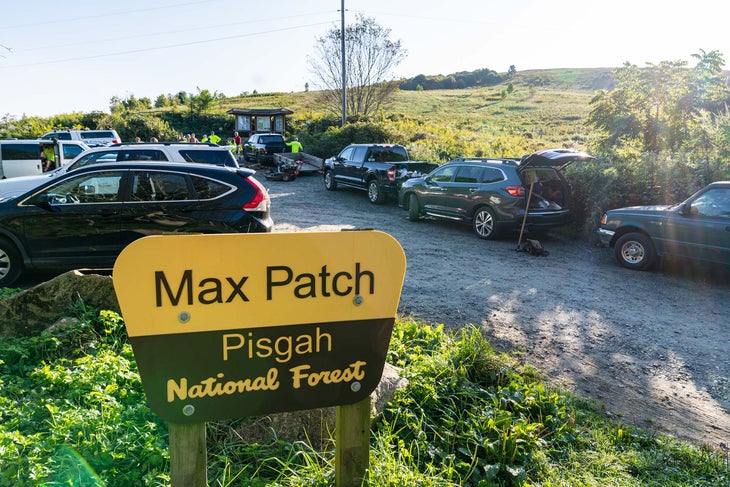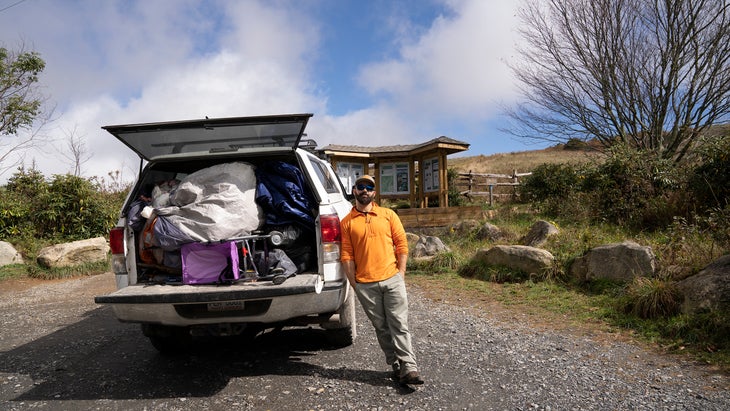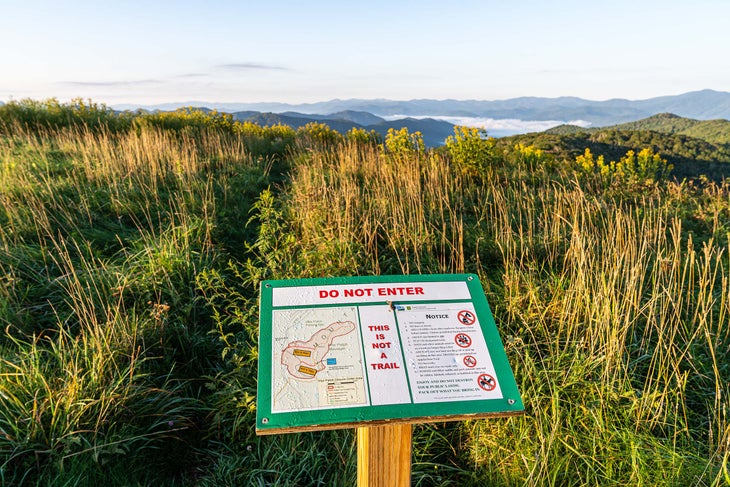Products You May Like
Get full access to Outside Learn, our online education hub featuring in-depth fitness, nutrition, and adventure courses and more than 2,000 instructional videos when you sign up for Outside+
Sign up for Outside+ today.
In September 2020, when news first broke that a legion of campers had left Max Patch in ruins, I told Backpacker “Every area has their own Max Patch. You know which places those are. Protect them before they’re loved to death.” Since then, we’ve had time to digest the new rules and regulations that event sparked—including a two-year ban on overnight camping—and analyze their impacts. I think it’s time to celebrate the progress we made, but consider a course correction.
I’ve got an ultra-local take on this situation: “The Patch” has been a playground since childhood. In truth, there is nothing the kids in the infamous drone photo, taken by Mike Wurman on September 19, 2020, were doing that I haven’t done. The only difference between us is that I picked up my trash. It reminded me of a more formative time in life when a party at “The Patch” was a rite of passage for youth from the surrounding communities. Many of us essentially learned to backpack there as we gathered for weekend parties and milestone events. If I’m being honest, my gut reaction when I first saw that soon-to-be-viral photo was “Damn, I’m sorry I missed that!”
My second reaction was to think about all the trash. Max Patch was one of the inspirations for the now worldwide #trashtag social media cleanup campaign that I started in 2015. Soon after I connected Backpacker’s writer with some local sources, I joined a cleanup effort at Max Patch along with other hikers and Pisgah National Forest rangers; collectively we removed a trailer full of trash. By participating in that clean up and serving as a conduit to Backpacker’s story, I hoped to shed light on a broken system at Max Patch and crowdsource a solution, not to shame anyone or end camping there.

I thought I was making a difference, fighting a just cause. The outcome, however, was not what I expected. On July 1, 2020, the U.S. Forest Service announced new rules and regulations, which included a two-year ban on camping and a closure of the area from one hour after sunset to one hour before sunrise. Violation of any of the new regulations would subject violators to a fine of up to $5,000 for individuals ($10,000 for groups), and up to 6 months imprisonment. While the Forest Service hasn’t officially said so, it seems likely that camping may remain banned there for good.
As someone who fell in love with overnight camping at ‘The Patch’, this is heartbreaking. Looking back, I think when most people saw the photo of Max Patch trashed, they pictured entitled millennials who didn’t know what they were doing, or care to learn. I harbored some of those feelings too, but I also saw young adults celebrating life on their first formative camping trip. I saw college students from our surrounding universities who could become environmental advocates and outdoor industry entrepreneurs, all falling in love with their public lands. In essence, I saw myself and my friends.
I also saw a popular place that was in desperate need of a fundamental change in its management. Max Patch, perhaps one of the most popular and easily accessible outdoor destinations in Appalachia, has no bathrooms, no trash facilities, no dedicated rangers and official parking for approximately 11 vehicles. Can we really act surprised that visitors aren’t doing their part to maintain it when they aren’t provided the proper facilities to do so?
Max Patch is magnificent, but it hasn’t been wilderness for a very, very long time. Local history has it that the MacMahon family cleared it as pasture in the 1800s. It’s been used as an airfield for sightseeing tours and by generations of campers; the Appalachian Trail only crossed its summit starting in the 1970s, when a group of passionate individuals rerouted it there from four and a half miles away. My point is that if we honestly wanted to preserve the land as it was, we’d have to start by eradicating the invasive gas-powered Brush Hogs which maintain ‘The Patch’ as a pasture and letting trees grow back so that Max Patch became just another unassuming hump on the 2,192 mile Green Tunnel. If we really wanted to commit ourselves to erasing present-day humans’ traces on Max Patch, we’d move the Appalachian Trail off of it too, just as God, and Benton Mckaye, intended.
Don’t get me wrong: I applaud the actions of the Pisgah National Forest and the Carolina Mountain Club for their efforts to manage and maintain Max Patch. But after the debacle there—fed, in part, by coverage in Backpacker and other outlets—the court of public opinion forced them to take action. And their actions worked: After recently visiting “The Patch” for a two-year progress report, I can unequivocally say that it is better than it was. The matrix of social trails are all but gone, and the actual trails have been laboriously improved. Wildflowers carpet the formerly trodden western slope. There is very little trash on the summit and less trace of human waste (save a few Charmin flowers).

The most noticeable difference, though, is the lack of established campsites on the summit. That leaves me sad: I saw a couple of my old go-to spots—places where I had watched many starry nights fade into day—just laying there, covered in what essentially amounted to nothing more than wasted hay. While the Forest Service may have banned camping with the best of intentions, I believe we would be making a generational public land management mistake if we permanently banned overnight camping at Max Patch. (The current ban officially runs until June 30, 2023).
Furthermore, I fear we may have set a very dangerous precedent for other beloved spots in Appalachia. If this dynamic becomes the new norm, It is only a matter of time before we lose overnight camping at Black Balsam or see access to the nearby Roan Highlands limited.
I think we should consider a course correction. Max Patch is easily-accessible, which makes it an ideal place to educate new campers on practicing Leave No Trace principles. We could make it fun, informative and interactive and make sure that everyone leaves the experience a better camper. Max Patch also has the potential to become one of the country’s most accessible epic overnight spots with limited improvements. I’m currently searching for an appropriate place to take my almost 70-year-old father, who suffers from Parkinson’s, on an overnight backpacking trip while he’s still able; if it were open, Max Patch would have been an ideal spot. With seemingly minimal improvement to the main trail, 75% of which is a Forest Service road, folks with limited mobility could roll up to the summit and enjoy a night outdoors in a truly fantastic setting.
My guess is that if we put in the proper facilities at Max Patch, 95% of people would pick up their trash and use the restroom properly. I know those facilities would cost money and we would need to pay someone to maintain them, and I get that money is hard to come by on public lands. And although I truly believe our public lands should be abundantly funded from the top down, I don’t see that becoming a reality anytime soon.

Maybe it’s time that we rethink our approach to camping on Max Patch. What if we put in 20 premium, yet primitive, camping spots on the summit? What if the Pisgah National Forest listed those sites on their website—or perhaps even contracted a third party like Hipcamp or Airbnb to do the listing—and we used the revenue generated to build bathroom and trash facilities, add a small ranger’s cabin and a new parking area at the base of Max Patch? Let’s imagine each campsite cost $50 a night—expensive, yeah, but not much more than many other, less-spectacular USFS sites—and there were 100 parking spots for $5 per spot. If Max Patch averaged 200 full days of occupancy per year, that works out to gross revenue of $300,000 per year—more than enough to pay for the infrastructure updates and premium salaries for the rangers who maintain the place.
This whole fiasco suggests a bigger question: Who gets to decide how we recreate and where do we draw the line between preservation and recreation? I don’t blame the people who advocated for new rules and regulations at Max Patch; after all, I was one of them. But while I and other advocates may have gotten what we originally wanted, it seems now that our main victory has been to preserve the rights of a human-created pasture at the expense of all the humans who used to enjoy it.
The Ed Abbey in me is rolling over in his grave at the mention of increased infrastructure, but I still see no other way—after all, Abbey never lived in the reality of the great outdoors’ post-pandemic popularity. I can’t stomach the thought of not being able to camp overnight or see the stars glow over Max Patch ever again. Fifty dollars a night would be a steep price to camp there, but I’d happily pay a lot more: If they close it for good and I grow to be an old man, I’ll have to risk the $5,000 fine—or the stint in jail—to camp on top of “The Patch” one last time.
